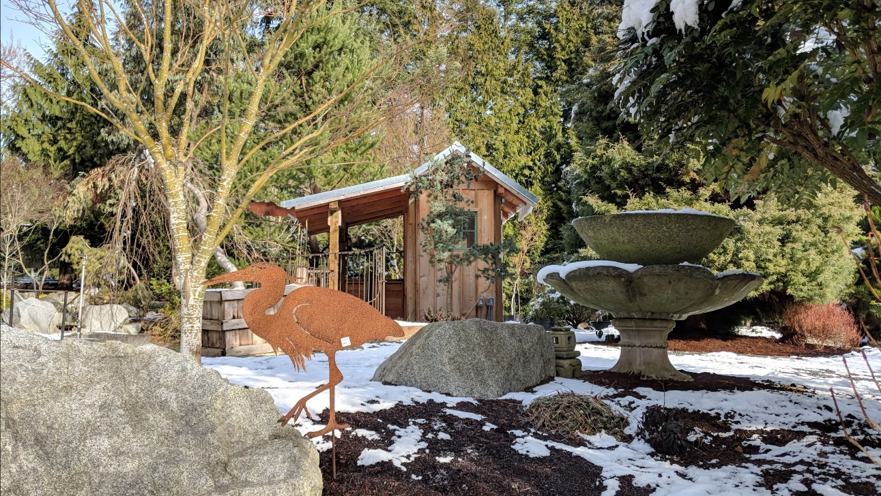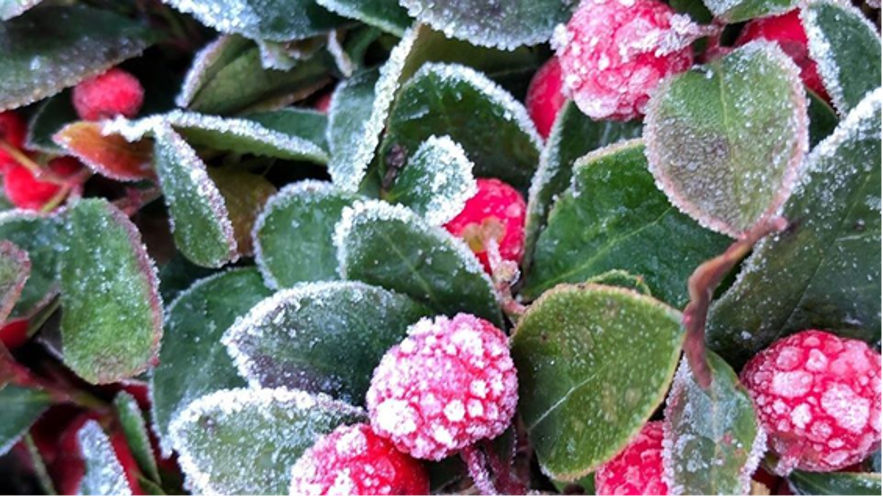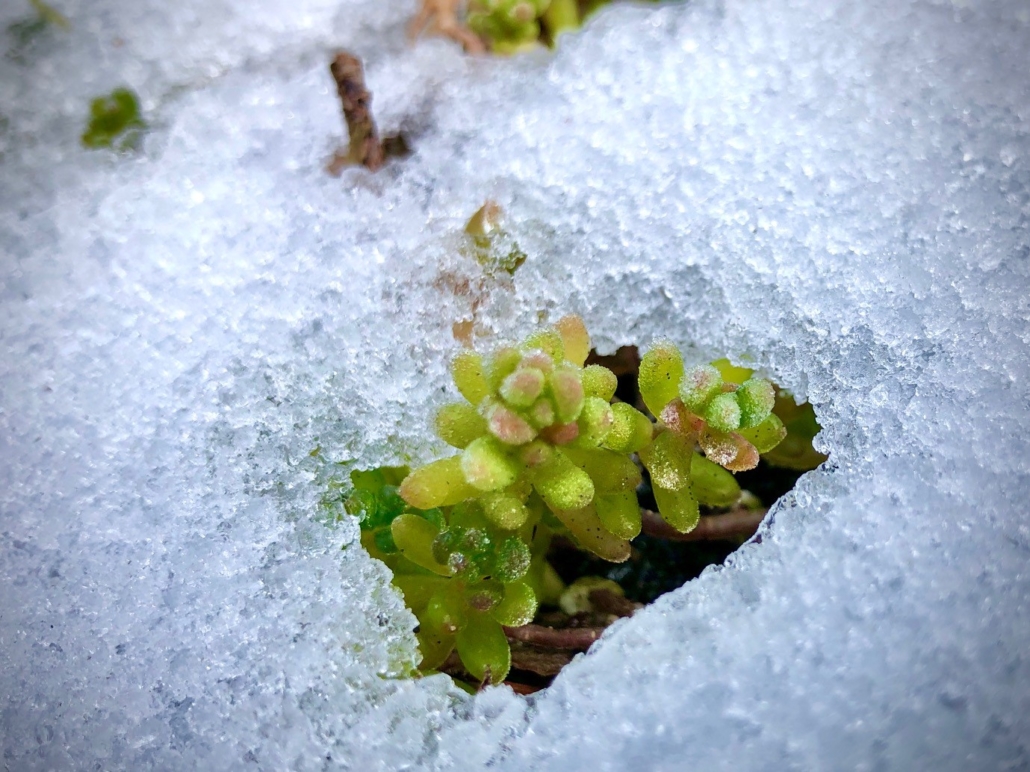Fall Garden Maintenance Tips
Fall is a busy time in the garden. Here are a few helpful tips and things to think about to help you be an effective gardener during this beautiful season.
Update Pots for Winter
This is a great time to give your pots a refresh. Dig out your summer annuals and replace them with fall and winter interest plants. Consider a colorful conifer for interest every day of the year. Get your flower fix by including a winter-flowering perennial like a Heather or Hellebore. Add some evergreen grass for texture, such as Bronze Carex or Blue Fescue. Tuck in a few seasonal annuals for splash. At this time of year, choose from Pansies, Cabbage Mums, or Cyclamen. Finish it off with something like Wintergreen, which offers red berries for a final bit of zip. Don’t forget to work in a few fresh handfuls of compost or manure to give your plants the fertility they need to be their best.
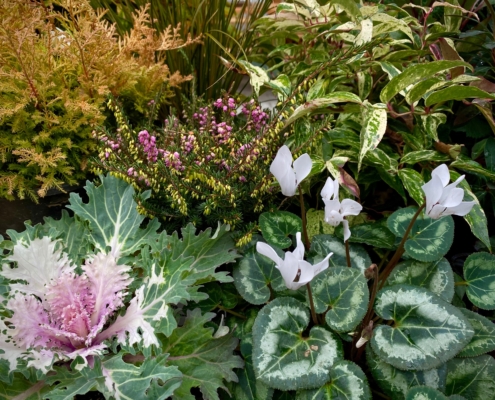
Protect Your Trees, Shrubs from Deer
Late fall/early winter is rutting season. This is when bucks rub their antlers and foreheads on trees, shrubs, fenceposts, etc. to release their scent and mark their territory. Surround your plants with fencing, monofilament, or deer spray to protect them from damage. Even “deer resistant” plants are eligible for rutting damage.
If you would like to read more about protecting your plants from deer, you can read this blog post.
Tidy Up with Care
Keeping a clean garden is important for disease prevention, but it is also important to consider the birds and bugs. Strategically leave some standing dead perennials to provide winter interest in the garden, as well as food for the birds.
Any flower in the daisy family makes seeds that small birds adore. Take the easy road – instead of deadheading your Brown-Eyed Susans, Asters, and Heleniums, leave them to form seed heads. When it snows, it’s really charming to watch little birds land on these stems and peck their dinners out!
Spent stems can be beautiful! Plants such as grasses, Iris, Phlomis, Artichoke/Cardoon, Yarrow, Agapanthus, and Allium make beautiful seed heads that provide lots of interest when left standing for the winter.
Don’t get too tidy in the garden or you can clean away habitat for nature’s helpers. Creatures like ground beetles, snakes, and lizards eat slugs, slug eggs, and other bothersome critters. They need the cover of stones, branches, and leaves to hide in during the winter. Create habitat for them by leaving some of your deciduous perennials “unkempt” for the winter. Letting the foliage die back naturally and rot provides cover. You can also leave a few small logs laying around, or create small piles of stones for them to hide in. Evergreen grasses, ferns, and perennials are also wonderful shelters for these garden friends.
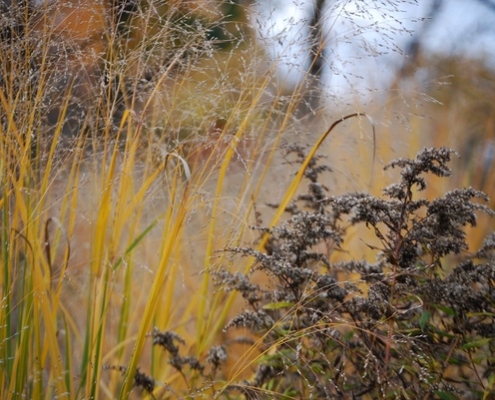
Stop the Pest and Disease Cycle
Keep your plants healthy next year by cleaning up diseased foliage now. Don’t perpetuate disease by composting the infected foliage; instead, throw it in the trash. This includes common garden plant diseases such as black spot, botrytis, powdery mildew, shot hole, and other fungal infections.
Prevent overwintering pests. If you have had an insect infestation in your garden, read up on how that critter overwinters, and take care to disrupt their overwintering habits in order to have fewer pests next year.
Those of us with fruit trees should clean up all fallen fruit to prevent overwintering of fruit pests such as Apple Maggot. Dispose of the fruit–do not compost it. Similarly, rake up and dispose of the leaves from any trees that have suffered from scab to prevent fungal spores from overwintering.
To cut or not to cut?
Some plants are puzzling! When should we cut them back? Here are a few ways to think about plants that I find helpful in analyzing what to cut back or not.
Meet the Silvers! These are plants like Lavender, Russian Sage (Perovskia), Lamb’s Ear (Stachys), Wormwood (Artemesia), Senecio, and so on. Pretty much any plant with silver foliage does NOT want to be cut back when it is chilly.
Another group is “plants on the verge.” These are plants that are on the verge of hardiness here in the PNW. These include any woody shrubs/perennials from warmer places, such as Pittosporum, Manzanita (Arctostaphylos), Grevillia, Leptospermum, Eucalyptus, Hebe, and so on.
Another group of plants that should NOT be cut back are the evergreen grasses. Plants such as Carex (of all types), Blue Oat (Helictotrichon), Blue Fescue (Festuca), Mondo (Ophiopogon), and Lilyturf (Ophiopogon) are all grasses that prefer to be left alone and should rarely be cut back! If these plants start looking tattered, you can cut them back in the spring when temps start to warm and your lawn is waking up. Follow a trim with an application of a nitrogen fertilizer for the best regrowth. Only cut these plants back every several years.
Reconfigure
Since fall is the best time for planting and transplanting, it’s a great time to take a fresh look at your garden. Did it work this year? Are there changes you’d like to make? Do you have enough winter interest? Take advantage of low-stress weather (for the digger and the plant!), as well as the many root-growth cycles that autumn and winter offer and make your garden edits and additions now.
Shop for Fall Color
The best time to buy a plant for its fall color is when it’s showing it. Come on over to Venture Out to see the show and make your selection. Here are a few of my favorite plants for fall foliage:
- Sumac (Rhus) ‘Gro-Lo’
- Dogwood (Cornus) ‘Baileyi’
- Cranberry Viburnum ‘Winterthur’
- Witch Hazel (Hamamelis)
- Cherry (Prunus)
- Maple, especially Acer ginnala
- Smoke Bush (Cotinus)
- Barberries (Berberis)
- Serviceberry (Amelanchier)
Shop for Winter Interest
When the leaves are falling, it’s a good time for plants to reveal their winter charms, bringing the focus to their forms, bark, or persistent berries/fruit. Here are a few of my favorite plants for winter interest:
- Oakleaf Hydrangea (Hydrangea quercifolia)
- Vine Maple (Acer) ‘Pacific Fire’
- Striped Bark Maple (Acer tegmentosum)
- Spindle Tree (Euonymus europea)
- Hawthornes Crataegus lavallei or ‘Winter King’
- Crabapples (Malus), especially ‘Golden Raindrops’
- Korean Dogwood (Cornus kousa)
- Stewartia pseudocamellia or monadelpha
And then, of course, there are all the colorful conifers that number too many to talk about here. (Learn more about my favorite conifers in this blog post.)
Protect and Improve Your Soil
This is the time for making compost, spreading compost, mulching, and for planting cover crops. Mulches and cover crops help protect your soil from erosion caused by winter rains. They can help keep nutrients from being carried away with the rain, and they can help prevent cool-season weeds from germinating.
Fall clean up offers lots of material for the compost. Remember that fallen leaves and spent plants are often a great source of trapped nutrients. Adding this plant material to your compost will make it more nutritious for the next plants to receive it. Maintain the potency of the compost pile by keeping it covered so rain doesn’t wash away all its goodness.
Prepare for spring beauty!
Look ahead and plan your spring garden now! Plant bulbs such as Daffodil, Hyacinth, and Tulip for a welcome blast of color in the spring. Protect them from squirrels digging by covering the planting area with a piece of hardware cloth staked over the bulbs. In my garden, Daffodils, Alliums, and Dutch Hyacinth are the most deer resistant of the bulbs.
Sow cool season annual seeds like Love in a Mist (Nigella) and Larkspur.
October and November are also the best months to plant garlic!
Prune
Once a plant has lost its leaves, it is safe for pruning. This is the easiest time to see the skeleton of the plants. It is really best to wait until the plant has been dormant for a while. Fall is an okay time for light pruning.
Winterize
Prepare for freezing and windy weather. Turn off and winterize your irrigation system. Drain and hang hoses. Protect spigots with insulating covers.
Bring in any tender patio plants that you wish to overwinter, such as Hibiscus, Princess Flower (Tibuchina), Bougainvillea, Mandevilla, Geranium, tender Succulents, and so on.
Windproof your garden. Store your patio furniture. Make sure row covers are weighted down. Tidy away buckets, watering cans, etc.
Slug and Snail Control
Whenever it is moist, slugs and snails flourish! Protect your plants by using a non-toxic, iron phosphate-based slug bait like Slug Magic or Sluggo. Products like these control the slug and snail population without causing danger to dogs and cats.
Certainly, this isn’t ALL there is to do in the fall garden, but hopefully this helps you get started!
Happy gardening!



